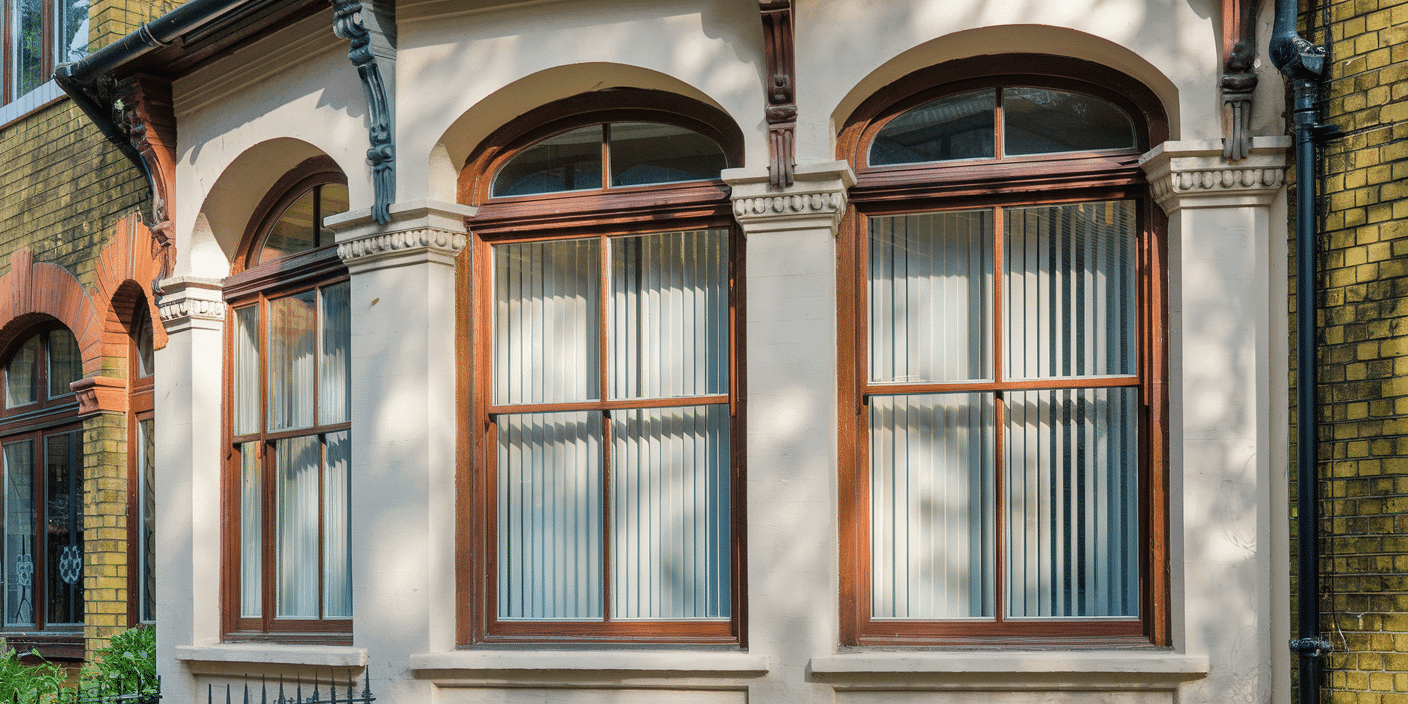The Silent Leak: Why Most Homes Quietly Fail Part L
Behind the charm of many British homes lies a persistent and often invisible problem: thermal inefficiency. While a living room may feel comfortably warm, behind every pane of underperforming glass, significant heat is being lost—continuously and expensively.
This is not anecdotal. It’s a measurable failure affecting thousands of properties across the UK—particularly where glazing systems have not kept pace with modern building standards.
With the latest changes to Part L of the Building Regulations, this issue is no longer academic. It’s enforceable. Whether you’re planning an extension, upgrading a period home, or specifying windows for a new development, the expectation is now explicit:
Window systems must achieve a U-value of 1.4 W/m²K or better.
This figure represents the rate of heat loss through a window per square metre, per degree of temperature difference. The lower the U-value, the better your insulation—and the lower your running costs.
Yet the majority of installed windows in the UK fall short of this benchmark. Specifically:
- Most legacy timber and aluminium frames exceed the allowable U-value
- Many double-glazed units still underperform
- Common uPVC installations, especially budget models, often fail in real-world conditions
The implications of non-compliance are immediate and far-reaching:
- Delays or rejections in planning approval
- Downgraded EPC ratings
- Compromised SAP scores and energy assessments
- Escalating heating bills year-on-year
These are not isolated risks—they are systemic, compounding, and directly tied to property performance and resale value.
Sash Windows London has spent years at the intersection of aesthetic sensitivity and engineering precision, crafting high-performance glazing systems that not only satisfy Part L, but do so without compromising architectural integrity.
This article explores one of the most effective solutions available today: the AluClad window system—a fusion of performance, compliance, and timeless design.
What Exactly Is a U‑Value — and Why Should You Care?
If you want to understand why some homes feel warm and effortless—and others bleed money every winter—you start with a single number: the U‑value.
Most homeowners have heard the term. Very few know what it means. And fewer still realise that the U‑value of their windows has a bigger impact on their home’s comfort, their annual bills, and their legal compliance than any boiler, radiator, or thermostat combined.
The U‑Value, in Plain English
A U‑value measures how quickly heat escapes through a building material.
It’s expressed in W/m²K—watts of heat lost per square metre, for every degree of temperature difference between inside and outside.
Put simply:
Lower U‑value = less heat lost = a warmer, cheaper-to-run home.
A window with a U‑value of 1.4 W/m²K loses heat twice as fast as one with a U‑value of 0.8 W/m²K.
Multiply that across every window in a home, and you begin to see the financial impact.
Why the U‑Value Matters Now More Than Ever
Part L of the Building Regulations tightened dramatically. The government isn’t nudging anymore—it’s enforcing.
Whether you’re replacing windows or specifying glazing for a new extension, your windows must now hit:
👉 U‑value of 1.4 W/m²K or lower
(And increasingly, architects are pushing for 1.2 or even 0.8 to future‑proof EPC ratings.)
Fail to meet that threshold and you risk:
- SAP assessment problems
- Planning friction
- Lower EPC rating
- Reduced resale value
- Higher energy bills for life
This matters not just on paper. You feel it every day—in rooms that cool too fast, in radiators working overtime, and in energy bills that creep year after year.
Why Your Existing Windows Probably Fail
Even windows installed within the last decade are unlikely to meet today’s standards. Most double‑glazed systems were built for a different regulatory era—one where “better than single glazing” was good enough.
- Legacy timber windows often sit at 2.0–3.0 W/m²K.
- Outdated uPVC units hover around 1.6–1.8 W/m²K.
- Standard aluminium frames conduct heat so efficiently they often drag U‑values above compliance levels.
The numbers simply no longer hold up.
Where Sash Windows London Enters the Conversation
For Sash Windows London, U‑values aren’t an afterthought—they’re the starting point. Before aesthetics, before joinery, before hardware choices, they engineer each system from the inside out to control the U‑value.
Because when you control heat loss, you control:
- comfort
- compliance
- running costs
- long‑term property value
And the single most effective way to achieve exceptional U‑values without sacrificing beauty?
You guessed it: modern AluClad window systems.
In the next section, we’ll look at why Part L isn’t just a regulation—it’s a line in the sand for every homeowner, architect, and developer.
Part L Isn’t Coming — It’s Already Here

You won’t get a warning. There won’t be a grace period. Part L of the Building Regulations is already in force, and it’s transforming how Britain builds, renovates, and specifies its homes.
Whether you’re working on a period property in Hampstead or a new-build in Surrey, if your windows don’t meet Part L’s strict thermal efficiency standards, you’re facing real consequences—financial, legal, and architectural.
What Is Part L — and Why It Matters to You
Part L sets the official benchmark for the conservation of fuel and power in buildings. It governs how much energy your home loses, how efficiently it retains heat, and how sustainable your construction choices really are.
It’s not a “nice to have” or a niche green building code. It’s the baseline legal requirement for:
- Extensions
- Conversions
- Renovations
- New builds
- Window replacements
And it affects everyone involved—homeowners, architects, developers, builders, and even estate agents. If your building fails to comply, the costs can be substantial.
The Key Number: 1.4 W/m²K
The new maximum U‑value for windows and doors in domestic refurbishments and builds is:
1.4 W/m²K
That means your glazing must lose no more than 1.4 watts of heat per square metre per degree of temperature difference.
But that’s the ceiling.
Most high-performance projects (especially architect-led or EPC-conscious ones) now demand U‑values of 1.2 or even 0.8 W/m²K, to ensure Part L compliance plus future-proofed energy performance.
What Happens If You Ignore It?
Let’s be brutally honest:
| Outcome | Risk |
| Planning Permission | Delays or outright refusals, especially for extensions or listed buildings |
| SAP Assessment | Lower scores lead to costly design revisions |
| EPC Rating | Missed targets affect resale, rental eligibility, and market valuation |
| Developer Sign-Off | Delayed handovers, non-compliance fines, and NHBC issues |
| Insurance/Grant Issues | Some eco-loans and green mortgages require compliance at the U-value level |
And here’s the clincher: Your window supplier won’t save you.
Most are still offering off-the-shelf, double-glazed units that just miss the mark—but come with outdated performance data or no spec transparency.
Enter Sash Windows London: Regulation-Ready by Design
While others scramble to retrofit compliance, Sash Windows London designs from regulation upwards. Every AluClad system they build is engineered to exceed Part L thresholds—not barely meet them.
- Engineered timber cores = better insulation
- Aluminium exterior cladding = zero-maintenance durability
- Triple glazing + warm-edge spacers = U-values as low as 0.8 W/m²K
But this isn’t just a technical advantage. It’s regulatory peace of mind, built in.
You don’t need to fight with your builder.
You don’t need to defend your planning submission.
You simply show the spec, pass the test, and move forward—with windows that look as good as they perform.
Why Most Windows Still Fail — Even the “Good” Ones
Walk through any upmarket neighbourhood and you’ll see gleaming white uPVC windows, slick aluminium frames, or even beautifully restored timber sashes. But behind the fresh paint and sales jargon, many of these windows are quietly failing—at the one job that matters most in today’s regulatory climate: keeping the heat in.
You’d be forgiven for thinking “double-glazed” means “energy efficient.” Or that timber automatically equals eco-friendliness. Or that aluminium must be modern and compliant. The truth is far less reassuring.
Most windows, even the seemingly good ones, can’t meet Part L requirements.
Let’s break down why.
The Myth of uPVC: Cheap Today, Costly Forever
uPVC has been sold for years as the “no-brainer” window choice: cheap, maintenance-free, and thermally efficient.
But here’s the catch:
- Many uPVC units still hover around 1.6–1.8 W/m²K in practice.
- They’re highly reliant on cavity size and seal performance.
- Frames are prone to warping over time, compromising air-tightness.
- Aesthetically? They flatten the character of period or high-end homes.
For homeowners chasing long-term performance and timeless appeal, uPVC becomes a false economy.
Standard Aluminium: Beautiful. Brutal on Heat Retention.
Aluminium offers slim sightlines and a sleek, architectural look. It’s durable and widely specified in modern projects.
But it’s also a highly conductive metal—meaning it leaks heat like a sieve unless properly thermally broken.
- Basic aluminium frames can rate as poorly as 2.0+ W/m²K
- Older systems lack the thermal break technology now needed
- Cold bridging from metal-to-metal connections causes condensation, mould, and heat loss
Unless it’s a high-spec composite or AluClad system, aluminium by itself is a regulatory liability.
Timber: Charming… Until the Bills Arrive
We love the craftsmanship of timber. The tactile grain, the heritage profiles, the sustainability story—it’s all compelling.
But in traditional form, solid timber is a thermal weak point:
- Can range between 1.9–3.0 W/m²K, depending on design and thickness
- Requires constant upkeep to avoid warping, rot, and air leakage
- Easily fails SAP assessments without additional interventions
- Planning officers may love the look—but Part L won’t bend for aesthetics
This puts homeowners and developers in a painful position:
Choose charm and fail compliance, or choose compliance and sacrifice design?
Where Most Suppliers Cut Corners
Let’s not pretend the industry isn’t partly to blame. Many window suppliers:
- Rely on old spec sheets from 5+ years ago
- Use generic “double glazing” labels without U-value guarantees
- Provide little to no data on frame performance
- Push products that just meet compliance in theory—but not on-site
- Don’t understand how their spec affects the SAP calculations that decide planning success
This leads to a dangerous assumption:
“I bought energy-efficient windows, so I’m covered.”
When in fact, you could be failing Part L, leaking energy, and compromising the value of your property.
Sash Windows London Doesn’t Play That Game
Rather than repackaging outdated products, Sash Windows London re-engineered the category.
With their AluClad window systems, they’ve solved what no one else has:
- Thermal excellence
- Visual authenticity
- Regulatory compliance
- Acoustic protection
- Design integrity
All in one system. No shortcuts. No surprises.
The Hybrid Revolution: How AluClad Solves It All
If traditional timber windows charm the eye but fail the thermal test, and aluminium systems excel in looks but falter on heat retention—what if you didn’t have to choose? What if you could have beauty and performance? Compliance and character?
Enter the AluClad window system—a hybrid innovation that delivers the best of both worlds, engineered with precision by the experts at Sash Windows London.
What Is AluClad?
At its core, AluClad is a composite window system:
- A timber internal frame for warmth and insulation
- Powder-coated aluminium exterior cladding for durability
- Triple-glazed, gas-filled glass units for low U‑values
- Thermally broken frames to prevent cold bridging
Think of it as timber with armour—engineered to protect your home from the elements, the regulations, and the rising cost of energy.
Thermal Performance Without the Aesthetic Penalty
Let’s talk numbers.
Sash Windows London’s AluClad systems regularly achieve U‑values as low as 0.8–1.2 W/m²K, comfortably beating the Part L benchmark of 1.4 W/m²K.
That’s not just compliant—it’s strategic.
- Warm-edge spacers reduce edge heat loss
- Argon gas-filled triple glazing maximises insulation
- Thermally broken frames ensure no metal-to-metal bridging
- Timber interiors regulate temperature naturally
Whether you’re targeting Passivhaus performance or simply want to lower your EPC-triggered energy bills, AluClad is the intelligent window spec.
Zero Maintenance. Forever.
Ask any homeowner with timber windows: beautiful as they are, they’re high-maintenance.
Not with AluClad.
- No painting
- No flaking
- No warping
- No weather damage
The aluminium exterior is powder-coated for durability, resisting UV damage, corrosion, and coastal weather conditions. That’s decades of protection with nothing but a wipe-down.
And inside? The timber remains untouched—warm, tactile, and fully visible.
Design That Pleases Planners and Architects
Sash Windows London has honed a unique craft: blending regulatory compliance with conservation aesthetics.
Their AluClad systems can be:
- Profile-matched to listed and period buildings
- Finished in any RAL colour (inside or out)
- Fitted with traditional sash-style bars or slimline casements
- Supplied with CAD files and specification data for architects
- Installed as part of heritage-sensitive renovation projects
No more compromising charm for compliance. No more being held hostage by building inspectors or planning officers. With AluClad, you take back control—visually and legally.
Built by Engineers. Specified by Architects. Loved by Homeowners.
Sash Windows London doesn’t just supply windows. They engineer systems that solve pain points and futureproof high-value properties.
Their AluClad offering is:
- Architect-specified
- Homeowner-approved
- Builder-friendly
- Regulator-proof
It’s the glazing solution that sits at the intersection of luxury, legislation, and legacy.
What It Looks Like, Feels Like, and Costs to Ignore It

It’s one thing to talk about U‑values, glazing systems, and compliance thresholds. But what’s it actually like to live with AluClad windows? What does your home feel like, look like—and what happens if you don’t make the change?
In this section, we bring AluClad from technical spec to lived reality—so you can understand its true value not just in numbers, but in comfort, experience, and long-term cost.
A Window That Feels Warm Before You Touch the Thermostat
The difference is immediate—and it’s not just in your head.
With AluClad systems from Sash Windows London, you experience:
- Even room temperatures, no cold spots near the glass
- Dramatically reduced draughts, even on windy nights
- Silent comfort, thanks to acoustic dampening from triple glazing
- Less condensation, less mould, and better air quality
Your home becomes a sealed envelope, holding warmth like never before—even in period properties, even on exposed elevations.
It’s not just compliance—it’s quiet, radiant comfort.
Peace You Can Hear — Or Rather, Can’t
Thermal insulation isn’t the only advantage. Sash Windows London’s AluClad systems also offer:
- Up to 45dB sound reduction
- Blissful quiet in bedrooms, nurseries, and studies
- City-centre calm—even with traffic just metres away
The triple-glazed, gas-filled units act as both a heat and noise barrier, transforming your home into a sanctuary.
Aesthetic Integrity That Never Ages
A common fear with performance glazing is that you’ll lose the charm of your home. Not here.
- Inside: natural timber, warm to the touch and finishable in oak, pine, walnut and more
- Outside: powder-coated aluminium, available in any RAL colour, built to endure UK weather
- Profiles: matched to sash or casement styles, with optional glazing bars and heritage details
You get modern performance wrapped in timeless elegance—no compromises.
The True Cost of Doing Nothing
Let’s talk numbers.
Choosing not to upgrade your windows might feel like the “safe” option. But it comes at a hidden price:
| Impact | Cost |
| Heat Loss | Up to 25–30% of your home’s total heat escapes through outdated windows |
| Energy Bills | Average UK home loses £300–£600 per year through inefficient glazing |
| Planning Risk | Failed SAP assessments and Part L non-compliance derail renovations and extensions |
| Property Value | EPC downgrades lower your home’s value and mortgage eligibility |
| Maintenance | Repainting, repairing, and sealing timber = ongoing costs and hassle |
Now compare that to one investment in Sash Windows London’s AluClad system—built to last, regulation-ready, and visually stunning.
Lifetime Peace of Mind, Engineered Into Every Frame
With Sash Windows London, you’re not just buying windows.
You’re buying out of the problem. For good.
- Future-proofed against upcoming building regs
- Zero-maintenance aluminium exterior
- Handcrafted timber interiors
- Proven performance data and compliance documentation
- Trusted by architects, developers, and discerning homeowners across Greater London
This is how glazing should feel: invisible, effortless, and unquestionably right.
Case Study: The Townhouse That Beat Part L Without Compromise
When Edward and Charlotte bought their Victorian townhouse in Wimbledon, they weren’t thinking about U-values. They fell in love with the sash windows, the cornicing, the charm. It wasn’t until the planning stage of their rear extension that they hit a wall.
Their architect flagged a red warning in the SAP report:
“Your current window specification fails to meet Part L requirements.”
The Problem
The couple wanted to retain the character of their period property.
Their original timber sash windows were elegant—but draughty.
Their extension design featured large glazing sections, and their initial supplier proposed double-glazed uPVC.
The issue?
- The proposed windows are rated at 1.6–1.8 W/m²K, above the Part L limit of 1.4
- They faced rejection from the planning office
- Their EPC rating was forecast to drop, affecting resale and remortgaging options
- They’d need to redo the SAP, delay the build, and risk further costs
And replacing all the windows with new timber ones? Too costly. Too high maintenance.
They needed a solution that balanced charm with compliance.
The Sash Windows London Approach
Edward was referred to Sash Windows London by a heritage architect who had faced similar issues on listed projects. The team conducted a free U-value consultation, assessed the building’s thermal envelope, and delivered a full technical specification.
The proposal?
AluClad timber composite windows with triple glazing and warm-edge spacers, delivering a U-value of 1.1 W/m²K—well under the Part L requirement.
- The exterior? Powder-coated aluminium, maintenance-free for 30+ years
- The interior? Oak-finished engineered timber to match the original design
- Profiles and glazing bars? Matched exactly to the townhouse’s heritage aesthetic
- Documentation? Fully Part L compliant with SAP-ready technical sheets
The Result
The windows were manufactured and installed within the build schedule. The planning office signed off immediately with zero objections. The SAP assessor revised the property’s score upward, leading to:
| Metric | Before | After |
| U-Value (average windows) | 1.8 W/m²K | 1.1 W/m²K |
| Projected EPC | D | B |
| Part L Compliance | ❌ Fail | ✅ Pass |
| Annual Heating Cost | ~£1,720 | ~£1,120 |
| SAP Delay Risk | High | Eliminated |
Edward and Charlotte not only secured the extension, but they also future-proofed the value of their entire home—without compromising on aesthetics, planning, or comfort.
“We didn’t just solve a regulatory problem. We made the house quieter, warmer, and more beautiful than it’s ever been.”
— Charlotte D., Homeowner, Wimbledon
Why It Matters
Most homeowners face the same choice:
Form or function. Beauty or compliance. Character or conformity.
Sash Windows London’s AluClad system erased the need for compromise.
For Edward and Charlotte, it didn’t just pass Part L—it elevated their home.
Book Your Free U‑Value Consultation with Sash Windows London
By now, it’s clear: the future of British housing isn’t just beautiful—it’s high‑performance, regulation-ready, and energy intelligent. Whether you’re upgrading a Victorian townhouse, designing a new extension, or building from the ground up, glazing is the one spec decision that can make or break your project.
And Sash Windows London is ready to make that decision effortless.
Why You Need a U‑Value Consultation Now
You don’t need to guess.
You don’t need to settle for generic double glazing.
You certainly don’t need to wait until Part L failure stalls your build or lowers your EPC.
With our free U-value consultation, you get:
✅ Precise calculation of your window U-values
✅ SAP and Part L readiness analysis
✅ Tailored window system specification
✅ Optional aesthetic recommendations for listed or conservation projects
✅ All documentation architects and builders need to move forward
What You’ll Walk Away With
- A compliance-ready specification sheet
- A clear understanding of how to improve or maintain your EPC rating
- A mapped solution that protects your planning permission
- An introduction to our AluClad system—custom-matched to your home
Whether you’re replacing a single bay window or undertaking a full retrofit, we’ll show you how to meet regulation, maximise comfort, and preserve the architectural soul of your property.
No Pressure. Just Clarity.
We’re not window salesmen. We’re compliance‑driven craftspeople who happen to engineer some of the most thermally efficient and visually striking window systems in the UK.
You won’t get a pushy upsell. You’ll get answers.
All you need to do is take the first step.
Schedule Your Free U‑Value Consultation Today
It costs nothing. It saves thousands. It could save your project.
Let Sash Windows London help you build a home that performs as well as it looks.







